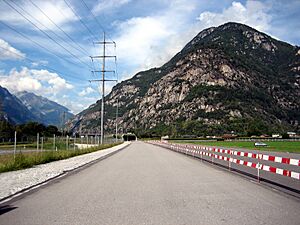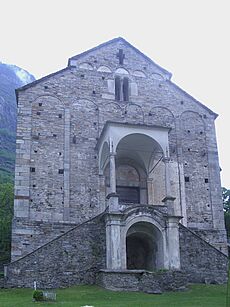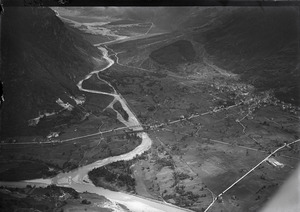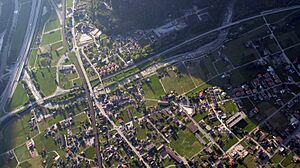Biasca facts for kids
Quick facts for kids
Biasca
|
||
|---|---|---|

View of Biasca and the surrounding valley
|
||
|
||
| Country | Switzerland | |
| Canton | Ticino | |
| District | Riviera | |
| Area | ||
| • Total | 59 km2 (23 sq mi) | |
| Elevation | 301 m (988 ft) | |
| Population
(Dec 2020 )
|
||
| • Total | 6,094 | |
| • Density | 103.3/km2 (267.5/sq mi) | |
| Postal code |
6710
|
|
| Localities | Biborgo, Cava, Fontana, Loderio, Mazzorino, Pontirone, Pontironetto (S.Anna), Sciresa, Sulgone | |
| Surrounded by | Cauco (GR), Iragna, Lodrino, Malvaglia, Osogna, Personico, Pollegio, Rossa (GR), Semione | |
Biasca is a lively town located in the Ticino region of Switzerland. It sits in the Riviera district, surrounded by beautiful valleys. Biasca is known for its important location on a major route through the Alps, which has shaped its history and economy over many centuries. It's a great place to explore Swiss culture and nature.
Contents
A Glimpse into Biasca's Past
Biasca has a long and interesting history. It was first mentioned way back in 830 AD! Over time, many different groups and rulers influenced the town.
Early Days and Rulers
In 948, the Bishop of Vercelli gave the Biasca area to the Bishop of Milan. This meant Milan had control over the valley north of Bellinzona. Biasca often saw armies marching through its valley during conflicts.
In the 12th century, a powerful family called the Orelli took control of a castle near Biasca. They also had the right to make important decisions for the village. However, in 1292, the villagers gained some power to choose their own local leaders. The Orelli family ruled until the mid-1300s. Then, the Visconti family from Milan took over.
Later, Biasca was given the right to choose its own Console, a local leader who could call courts. This right was confirmed many times. In 1403, after the Duke of Milan died, two Swiss regions, Uri and Obwalden, took over Biasca. But in 1422, Milan's troops fought back and won at the Battle of Arbedo, taking Biasca back.
Under Swiss Control
In 1439, Uri attacked Biasca again. The Duke of Milan strengthened Biasca's defenses. In 1441, he made it a stronghold against Uri. Uri occupied the town again in 1449. In 1450, Biasca made an agreement with the new Duke of Milan, Francesco Sforza, which kept their special rights.
Biasca was likely fully joined with the Swiss in 1495. After 1500, it became part of the Riviera region under Swiss rule.
Natural Disasters and Recovery
In 1512, a huge landslide from Monte Crenone blocked the Brenno river. This created a large lake, about 14 kilometers (9 miles) long, above the village. But in 1515, the natural dam burst! This caused a lot of damage to the town.
Despite this disaster, Biasca slowly recovered. Its location on a major Alpine trade route helped the local economy. However, in the late 1500s and early 1600s, several serious plague outbreaks hit the town.
Trade and Economy in the Past
Biasca has always been important for trade because it's at the entrance to several Alpine valleys. Even after the Gotthard Pass opened in the 1200s, Biasca remained a key stop. The Orelli family collected tolls on the roads. Later, Biasca had a special warehouse for goods being moved through the mountains. From 1434, the town collected a fee on goods transported over the passes. Besides trade, people earned money from forestry, agriculture, and raising livestock.

Modern Changes and Growth
The building of new roads in 1815 and the Gotthard Rail Tunnel changed Biasca a lot. It became less of a farming village and more of a modern town. For a while, the silkworm industry was big in Biasca. The granite mining industry also became very important around 1900.
In recent years, Biasca's economy has grown a lot, especially in industry and services. Farming is now a very small part of the economy. The Biasca industrial zone is considered very important for the whole region. Biasca has also become a central point for services in the Tre Valli area. With new rail links like the NEAT (New Alpine Transversal), Biasca is expected to keep growing.
Churches of Biasca
The parish church of San Pietro is very old, dating back to the 11th century. It was a major church for the "Ambrosian Valleys," a region known for its special church traditions. The Church of SS Giacomo e Filippo was finished in 1468 but was later destroyed in wars. The Rotonda di San Carlo is a beautiful example of modern church architecture.
Biasca's Geography
Biasca covers an area of about 59.13 square kilometers (22.83 sq mi). A large part of this land, about 45%, is covered by forests. About 4.8% is used for farming, and 4.9% has buildings or roads. Rivers and lakes make up 2% of the area, and 36.7% is unproductive land, like rocky areas.
The town is located in the Riviera district, where the Leventina, Blenio, and Riviera valleys meet. It's about 19 kilometers (12 miles) north of Bellinzona, right by the Brenno river. About 3 kilometers (2 miles) east of Biasca, there's a small lake called Carigiolo. A stream flows from this lake, creating an impressive 80-meter (260 ft) waterfall! Several smaller villages, like Loderio and Pontirone, are also part of the Biasca municipality.
Biasca's Coat of Arms
The coat of arms for Biasca shows a silver shield split down the middle. On one side, there's a blue snake standing upright. On the other side, there's a black eagle with red beak and claws. At the top, on a red band, there are two silver keys crossed over each other and tied with a ribbon.
Who Lives in Biasca?
Biasca has a population of about 5,935 people. Many different nationalities live here. Most people (about 86.7%) speak Italian. Other languages spoken include Albanian and Serbo-Croatian.
In 2009, about 9.3% of the population were children aged 0-9, and 10.3% were teenagers aged 10-19. The town has a good mix of young people, adults, and seniors. Many people who live in Biasca were also born there.
Important Heritage Sites
Biasca is home to some important historical sites. The Arsenale (a former military building) and the main church of SS. Pietro e Paolo are listed as Swiss heritage sites of national significance. This means they are very important cultural landmarks for the country. The town of Biasca itself, along with the village of Pontirone, is also part of the Inventory of Swiss Heritage Sites.
Economy and Jobs
In 2007, Biasca had an unemployment rate of 4.82%. Most jobs in Biasca are in the service sector (like shops, hotels, and healthcare) and the industrial sector (like manufacturing and construction). Only a small number of people work in farming.
Many people who live in Biasca also work there. About 7.2% of workers use public transportation to get to work, while 61.4% use a private car. In 2009, Biasca had 4 hotels with 70 rooms, showing its role in tourism.
Religion in Biasca
Most people in Biasca are Roman Catholic, making up about 73% of the population. There are also people who belong to the Swiss Reformed Church and various Orthodox churches. A smaller number of people are Islamic, Buddhist, or Hindu. About 9.28% of the population do not belong to any church.
Weather in Biasca
Biasca gets a good amount of rain or snow each year, averaging about 97 days with precipitation. The wettest month is usually May, while December is the driest.
Learning and Education
Education is important in Biasca. About 32.6% of the population have finished high school, and 6.4% have gone on to higher education, like university.
In 2009, there were over 1,000 students in Biasca. The education system includes:
- Non-mandatory kindergarten (up to three years).
- Five years of primary school.
- Lower secondary school, which can be a two-year middle school or a four-year program to prepare for higher education.
- Upper secondary school, which prepares students for trades or university.
Many students from nearby areas come to Biasca for school, and some Biasca residents attend schools outside the municipality.
Transportation Hub
Biasca is well-connected by transport. The Biasca railway station is right in the town and is part of the important Gotthard railway line. This makes it easy to travel to and from Biasca.
Sports in Biasca
Biasca is home to the HCB Ticino Rockets, an ice hockey team. They play in the Swiss League (SL) and are connected to two bigger teams, HC Lugano and HC Ambrì-Piotta. Their home games are played at the Raiffeisen BiascArena, which can hold 3,800 fans.
Famous People from Biasca
Biasca has been the birthplace or home of several notable people:
- Roberto Donetta (1865–1932): A famous photographer.
- Aurelio Galfetti (born 1936): A well-known architect.
- Giuseppe Miccolis (born 1976): An Italian football (soccer) player.
Images for kids
December 2020
See also
 In Spanish: Biasca para niños
In Spanish: Biasca para niños













